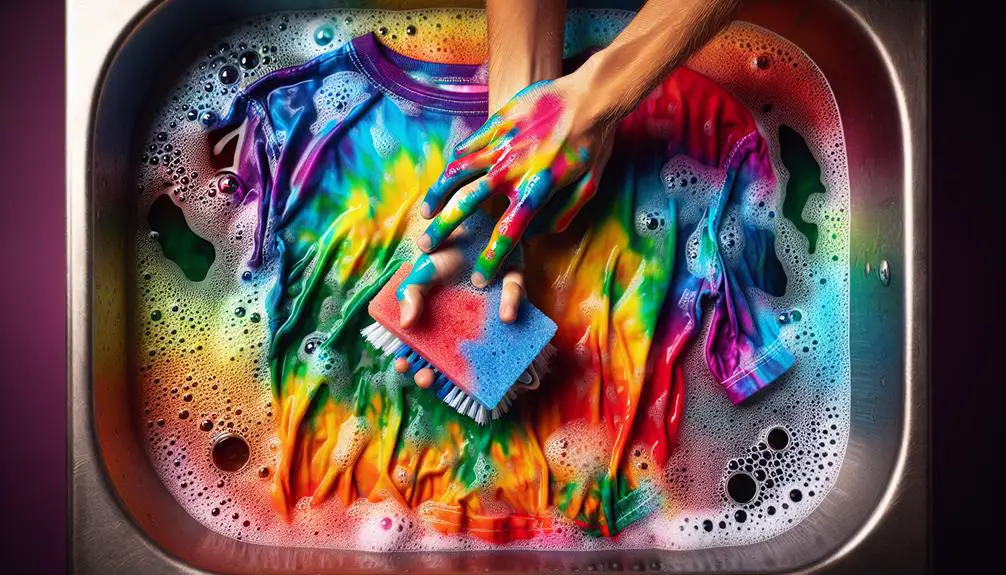Addressing a color run on clothes can be a challenging task, but fear not; I've got some tricks up my sleeve to help you tackle this colorful conundrum.
Have you ever wondered how to restore your favorite garments to their former glory after a color mishap? Well, fret not as I unveil some practical solutions to bid farewell to those unwanted dye stains.
Let's uncover the secrets to reviving your wardrobe and bringing back the vibrancy to your outfits.
Table of Contents
Key Takeaways
- Separate colors from whites to prevent color runs.
- Use color catcher sheets to trap loose dyes.
- Utilize vinegar for effective stain removal.
- Act quickly and avoid vigorous rubbing for successful color run removal.
Understanding Color Run Stains
Color run stains, also known as dye transfer stains, occur when colored materials transfer dye onto fabric during the washing process. To prevent color run, it's crucial to separate colored garments from whites before washing.
Adding a color catcher sheet to the laundry can also help trap loose dyes and prevent them from transferring onto other clothes. Additionally, avoiding washing colored clothes with bleach residue on them is key, as this residue can lead to color runs when in contact with other fabrics.
When dealing with white garments stained from color run, it's important to use specific laundering techniques tailored for removing dyes without damaging the fabric. Identifying the source of the color run is essential for preventing future incidents and taking quick action with proper treatment can effectively remove color run stains from clothes.
Assessing Fabric and Dye Type
When dealing with color run stains on clothes, understanding the fabric and dye type is crucial for effectively determining the appropriate removal methods. Assessing fabric and dye type is the first step in tackling color run stains successfully. Here are some key points to consider:
- Fabric Reaction: Different fabrics react uniquely to color run removal techniques. For example, cotton may respond well to certain methods, while silk or wool may require gentler approaches.
- Dye Type Compatibility: Take into account the dye type used in the garment. Some dyes are more resistant to removal methods, requiring specialized treatment to avoid damage to the fabric.
- Tailored Approaches: Consider the specific characteristics of both the fabric and dye type to tailor your stain removal approach effectively. Matching the removal method to these factors increases the likelihood of successful stain removal without causing harm to the garment.
Quick Action: Blotting and Rinsing
When dealing with color runs on clothes, remember to act quickly by blotting with cold water and rinsing under running water.
These simple steps can help prevent the dye from setting and minimize color transfer.
Blot With Cold Water
To tackle color runs on clothes effectively, start by promptly blotting the affected area with cold water. Remember, quick action is key to prevent the dye from setting into the fabric.
Here are some tips to help you tackle color runs successfully:
- Use a clean cloth or paper towel to absorb as much dye as possible from the fabric.
- Avoid rubbing the stain vigorously, as it can spread the dye further into the fabric.
- Be gentle but thorough when blotting to minimize the impact of the color run.
Rinse Under Running Water
After blotting the affected area with cold water to remove excess dye, the next step is to swiftly rinse the stained fabric under running water to prevent further color setting.
When rinsing, ensure the water is cold, as hot water can actually set the color into the fabric. By rinsing under running water, you're actively flushing out the dye particles, aiding in the removal process.
Focus on the areas with the most intense color saturation, as these are likely to require more attention. Keep rinsing and gently rubbing the fabric together to help release the dye.
Continue this process until the water runs clear, indicating successful removal of the color. Remember, prompt rinsing is key to effectively removing color runs from clothes.
Utilizing Vinegar for Stain Removal
For effective removal of color run stains, soaking discolored garments in distilled vinegar proves to be a reliable method. Vinegar's acidic nature helps to break down the color molecules, making it easier to lift the stains from the fabric.
Here are some simple steps to effectively utilize vinegar as a colour run remover:
- Soak the Garments: Submerge the affected clothing items in a mixture of water and distilled vinegar for at least 30 minutes to allow the vinegar to penetrate the fibers and work on the stains.
- Consider Optional Step: If the stains are stubborn, consider adding a small amount of non-chlorine bleach to the vinegar solution for enhanced stain removal power.
- Rinse and Wash: After soaking, rinse the garments with lukewarm water to remove excess vinegar, then proceed to wash them in cold water with detergent to completely eliminate the stains.
Nail Polish Remover for Tough Stains
When tackling tough stains on clothes, consider utilizing acetone nail polish remover as a potent solution for deep-seated color run stains. Acetone is highly effective in breaking down dye molecules, making it easier to lift stubborn stains from fabric. To use acetone on stains, apply a small amount to a cotton ball and dab the affected area gently. It's essential to act promptly and wash the garment after using acetone to prevent any potential fabric damage.
Here is a table to summarize the key points when using acetone nail polish remover:
| Acetone Nail Polish Remover for Stains | |
|---|---|
| Effectiveness | High |
| Application | Cotton ball |
| Precautions | Prompt washing |
Using Color Remover Products
Color remover products are a convenient solution for tackling stubborn color runs on white clothing.
Following the instructions provided on the product is essential to achieve optimal stain removal results.
Remember to wash the garment thoroughly after using the color remover to ensure all traces of the stain are gone.
Color Remover Application
To effectively remove color runs from clothes using color remover products, it's essential to follow the instructions provided on the product for optimal results. When applying a color remover:
- Ensure to wear protective gloves to prevent skin irritation.
- Mix the color remover solution according to the package instructions.
- Apply the solution to the affected area and gently work it into the fabric before rinsing thoroughly.
Color removers are powerful tools, but correct application is key to success in restoring your garment's color.
Follow Product Instructions
As I tackle the process of utilizing color remover products, my primary focus lies in adhering meticulously to the instructions provided on the product packaging to achieve successful color run removal. It is crucial to follow the specific guidelines outlined by the manufacturer to ensure effective stain removal without damaging the fabric. Here's a helpful table to summarize key points:
| Color Remover Product Instructions |
|---|
| Follow product directions precisely |
| Use recommended soaking, rinsing, and drying techniques |
Wash Garment After
After using color remover products, remember to wash the garment to ensure complete removal of color run stains.
Here are three essential steps to follow when washing the garment after using a color remover:
- Use a Washing Machine: Place the garment in the washing machine to thoroughly clean it.
- Select the Correct Settings: Choose the appropriate water temperature and cycle based on the garment's care label.
- Use Detergent: Add a gentle detergent to the wash to help remove any remaining traces of the color remover and stains.
Following these steps will help ensure that your garment is free from any lingering color run stains after using a color remover product.
Separating Laundry: Whites Vs. Colors
When it comes to sorting laundry, a simple yet crucial step is separating whites from colors to maintain garment quality and prevent color runs. Washing whites and colors separately not only helps prevent color bleeding but also maintains the vibrancy of the garments. By separating laundry by color, you reduce the risk of color transfer during the washing process. Whites should always be washed with other whites to avoid potential discoloration from colored items. Mixing whites with colored clothes can lead to color runs, affecting the overall appearance of the garments. Properly sorting laundry by color ensures that each item retains its original hue and quality after washing.
| Category | Whites | Colors |
|---|---|---|
| Washing | Separate whites from colors | Wash similar colors together |
| Temperature | Use hot water for whites | Use cold water for colors |
| Detergent | Use bleach for whites | Use color-safe detergent |
| Drying | Dry whites in sunlight | Tumble dry colors |
| Ironing | Iron whites at high heat | Iron colors at medium heat |
Tips for Washing New Clothes
To ensure the longevity and vibrancy of your new clothes, always remember to wash them separately to prevent color bleeding. When dealing with new garments, especially bright-colored ones, taking extra care in the washing process can make a significant difference in maintaining their original appearance.
Here are some tips for washing new clothes effectively:
- Wash Bright-Colored Garments Separately: New bright-colored items are more prone to color bleeding, so it's crucial to wash them separately to prevent any unwanted staining on other clothes.
- Hand-Wash with Similar Colors: Hand-washing new items with similar colors can help ensure that the dye sets properly and minimizes the risk of color run during the first wash.
- Follow Care Instructions: Always check the clothing labels for specific care instructions tailored to your new clothes. This will help you understand the best way to wash and care for each item to maintain its quality over time.
Double-Checking Before Drying
Before tossing your clothes into the dryer, it's crucial to thoroughly inspect them for any signs of color run to prevent potential damage. Check each garment carefully, especially colored items that may bleed onto whites.
Look for color bleeding or transfer on both colored and white pieces to avoid setting stains during drying. If you notice any color bleeding, avoid putting the clothes in the dryer as heat can further set the stains and damage the fabric.
Take a moment to double-check all items for colorfastness and color transfer before using the tumble dryer. This simple step of inspecting your clothes before drying can save you from irreversible damage caused by color run.
Preventing Color Runs in the Future
Hey there! Want to keep those colors vibrant and prevent any more color runs in the future?
Remember to wash similar colors together and use cold water for non-colorfast items.
Don't forget to conduct a quick colorfastness test before washing to ensure your garments stay looking their best!
Colorfast Fabrics Tips
Colorfast fabrics, such as cotton, polyester, and nylon, are key in preventing color runs in the future due to their ability to retain color and resist bleeding during washing.
When dealing with colorfast fabrics, here are some tips to keep in mind:
- Check garment labels for colorfastness information to determine if they're prone to color bleeding.
- Colorfast fabrics undergo special processes or treatments to lock in color and prevent bleeding.
- Choosing colorfast fabrics can help reduce the risk of color runs in the future.
Sorting by Color
To prevent color runs in the future, it's crucial to sort your laundry by color to avoid color bleeding between different items. Washing similar colored items together significantly reduces the risk of color transfer during the laundry process.
Hand-washing non-colorfast items in cold water can also help prevent color runs in the future. Before washing, conducting a colorfastness test can determine if a garment will bleed color and potentially cause a color run. To test for color transfer, rub an inside seam with a cotton bud.
This simple step can help prevent color runs in the wash by identifying items that may bleed and allowing you to wash them separately to preserve the colors of your favorite clothes.
Bonus Tips for Stain Removal
When dealing with stubborn stains, incorporating a few bonus tips can enhance your stain removal efforts significantly. Here are some additional techniques to help you tackle color run stains effectively:
- Hydrogen Peroxide: Dabbing a mixture of hydrogen peroxide and water on the stained area can help lift stubborn color stains. Remember to test on a small, inconspicuous area first to ensure it won't damage the fabric.
- Lemon Juice and Sun: Applying lemon juice to the stain and letting it sit in the sun can act as a natural bleaching agent, helping to fade the color run. Be cautious with delicate fabrics and avoid this method for dark-colored clothing.
- Baking Soda Paste: Creating a paste with baking soda and water and gently scrubbing it onto the stain can help absorb excess color. Let it sit for a while before rinsing it off. This method is particularly useful for fresh stains.
Frequently Asked Questions
How Do I Remove Colour Run From Clothes?
To remove color run from clothes, act promptly. Soak in vinegar, use a color remover for whites, wash separately, air-dry. These steps help lift the dye and prevent further staining. It's crucial to follow these methods for effective stain removal.
How Do You Get Color Bleed Out of Clothes?
When color bleeds on clothes, act swiftly. I've found vinegar, nail polish remover, and color removers effective. Wash colors and whites separately always. Check labels for care instructions. Quick action boosts stain removal success.
How Do You Get Dye Transfer Out of Clothes?
To get dye transfer out of clothes, I soak the garment in a solution of vinegar or color-safe bleach, then wash it in cold water with a color-safe detergent. I air-dry the clothing to prevent further dye setting.
How Do You Remove Color Spread From Clothes?
To remove color spread from clothes, soak in vinegar or try a color remover. For tough stains, use acetone nail polish remover before washing. Follow product instructions carefully. Wash clothes separately by color to prevent future color transfer.
- Recycling Nonwoven Fabrics: Is It Possible? - July 11, 2025
- Recycling Nonwoven Fabrics: Is It Possible? - July 11, 2025
- Recycling Nonwoven Fabrics: Is It Possible? - July 11, 2025







